Physical Address
304 North Cardinal St.
Dorchester Center, MA 02124
More than a million patients in North America live with some type of intestinal stoma. These stomas are typically constructed as one of the last components of a long and challenging surgical procedure. Stomal construction is important because their function will have significant impact on the ostomate's life. Stomal creation is a technical exercise that if done correctly will result in good function and minimal complications for the remainder of the ostomate's life. Conversely, if created poorly, stoma complications are common and can lead to years of misery. Intestinal stomas are in fact enterocutaneous anastomoses, and all the principles that apply to creation of any anastomosis (i.e., using healthy intestine, avoiding ischemia and undue tension) are important in stoma creation. This chapter reviews construction and management of ileostomies and colostomies.
Stomas are created either as a temporary means of fecal diversion when an anastomosis is unsafe or unwise, or as permanent orifices for the passage of stool or urine when surgical resection prohibits the body's normal orifices from accomplishing these tasks.
Permanent colostomies are usually created from the sigmoid or descending colon, usually in association with distal bowel resection. Colostomies proximal to the splenic flexure function poorly, are often placed in locations difficult for ostomates to manage, and are at high risk for complications. If a permanent colostomy is contemplated using the transverse or ascending colon, the surgeon should strongly consider resecting the remaining large bowel and creating an end ileostomy. Common indications for a colostomy are listed in Box 178.1 .
Rectal cancer
Radiation proctopathy
Incontinence
Refractory anorectal Infection
Ischemia
Crohn disease
Diverticular disease
Sacral decubitus
With the development and general acceptance of the ileal pouch–anal anastomosis (IPAA), permanent ileostomies are currently less common. Nonetheless, permanent ileostomies are created for inflammatory bowel disease, familial adenomatous polyposis, multiple synchronous colorectal cancers, and a variety of other miscellaneous disorders. Poor anal function, comorbid diseases, or quality of life considerations may make an ileostomy preferable to more complex reconstructive options in selected patients.
Temporary diverting stomas are usually created in association with distal bowel resections when anastomosis is unsafe or to protect a distal anastomosis when operative conditions or comorbidities make proximal diversion of the fecal stream prudent. Three types of diverting stomas predominate: end sigmoid colostomy, loop colostomy, and loop ileostomy.
Patients undergoing either elective or emergency surgery in which the creation of an abdominal stoma is a possibility should have adequate preparation preoperatively. Emergent surgery dictates a more rapid preparation than elective surgery, but stoma considerations must not be neglected.
Many patients lack knowledge of intestinal stomas. A few minutes of preoperative education by the surgeon combined with printed material is very helpful. In addition, if available, all patients should meet with a wound ostomy care nurse (WOCN) or enterostomal therapist (ET). The WOCN can provide specific information regarding stoma appliances, dietary and clothing alterations, and pouch management. Most importantly, the WOCN will help to select the appropriate abdominal wall site for the future stoma. Appropriate stoma placement decreases postoperative complications and may improve the ostomate's well-being. Bass et al. showed that preoperative counseling and marking by an ET prior to surgery improves postoperative quality of life.
In addition to meeting with a WOCN, patients scheduled for stomal surgery often benefit from the opportunity to meet with other ostomates. Patients who have adjusted to life with a stoma provide an excellent, nonmedical source of information and are often glad to share their experience with new ostomates. In addition, local chapters of the United Ostomy Association of America and the Crohn's and Colitis Foundation may be of benefit in this area.
Patients should have their stoma site marked prior to surgery. An abdominal surgeon should be able to locate and mark stoma sites. In most circumstances, marking is simple, straightforward, and requires only a few minutes. Three abdominal wall landmarks outline the ostomy triangle ( Fig. 178.1 ): the anterior superior iliac spine, pubic tubercle, and umbilicus. The stoma should lie within this triangle overlying the rectus muscle, generally at the site of an infraumbilical bulge in the abdominal wall. A site should be located on a flat segment of the abdominal wall 5 cm away from bony prominences, the umbilicus, prior surgical scars, or skin folds. After the site has been selected and marked, the patient should sit up to ensure any new skin folds do not interfere with the stoma site. The patient's beltline should be identified and avoided if possible because this decreases postoperative clothing restrictions.
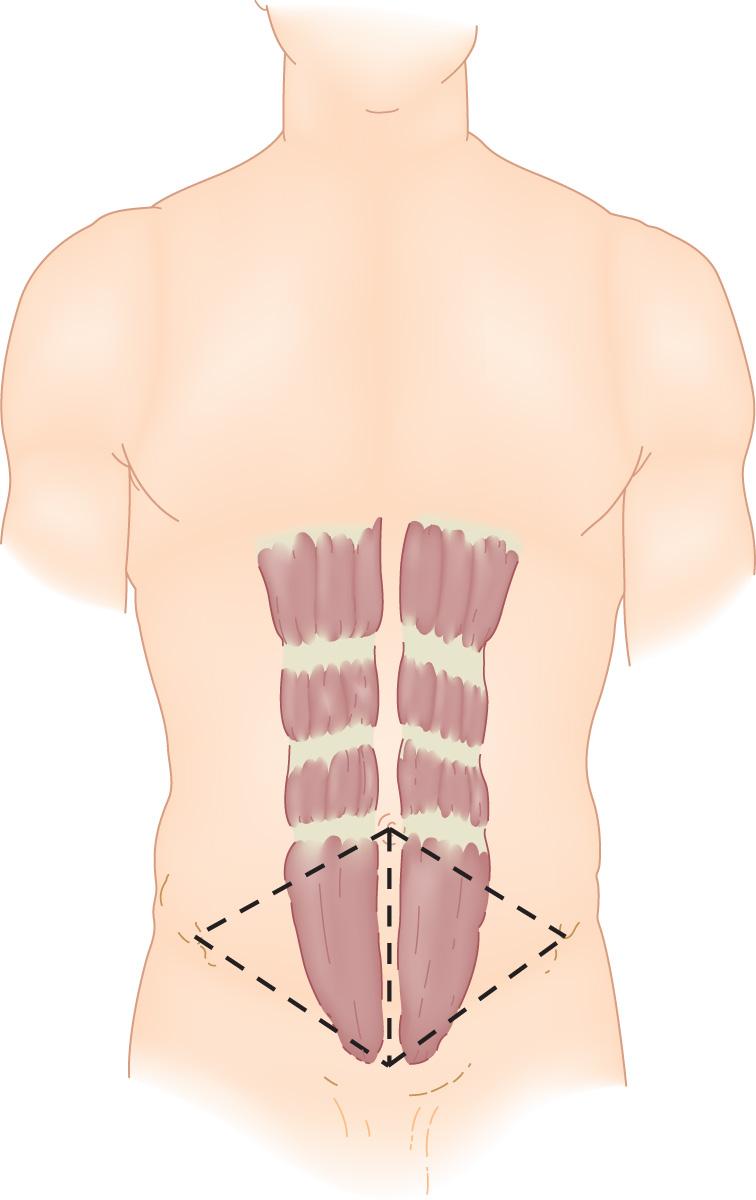
Special circumstances may require additional consideration. In obese individuals, a large pannus may preclude stoma placement below the umbilicus. The pannus is often thicker in this area and may also hide the stoma from the patient's vision, making management difficult. Patients confined to a wheelchair should be marked while in their chair to avoid unanticipated postoperative difficulties. As mentioned, despite these restrictions, the stoma should pass through the rectus abdominal muscle to decrease the complications of parastomal hernia and stomal prolapse. In complex or potentially problematic cases, a stoma site can be marked and the stoma appliance left in place for 24 hours to determine the accuracy of preoperative placement. Other challenges can be addressed with such procedures as abdominal wall contouring (described later).
End ileostomies are routinely performed in association with either partial or total colorectal resections. Exposure is generally through a midline incision, and the stoma is created after performing the indicated bowel resection. The premarked stoma site (usually in the right lower quadrant) is excised ( Fig. 178.2 ). A skin disc the size of a quarter is removed, sparing all subcutaneous fat because this fat is helpful to support the stoma in the postoperative period. The fat is then separated with cautery to expose the anterior rectus sheath. The sheath is incised vertically with cautery for 3 to 4 cm ( Fig. 178.3 ). The rectus abdominis muscle is split in the direction of its fibers to expose the posterior sheath. With the nondominant hand protecting the underlying viscera, the posterior sheath is opened with cautery and the defect is enlarged to admit two fingers ( Fig. 178.4 ).
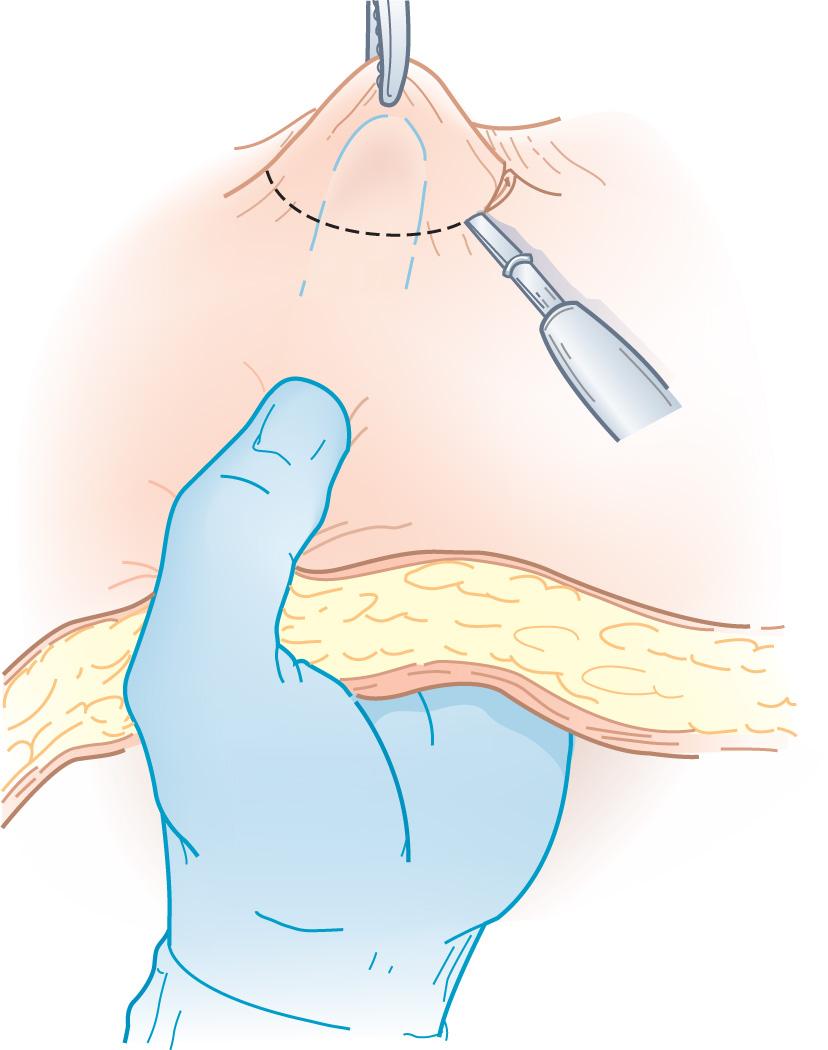
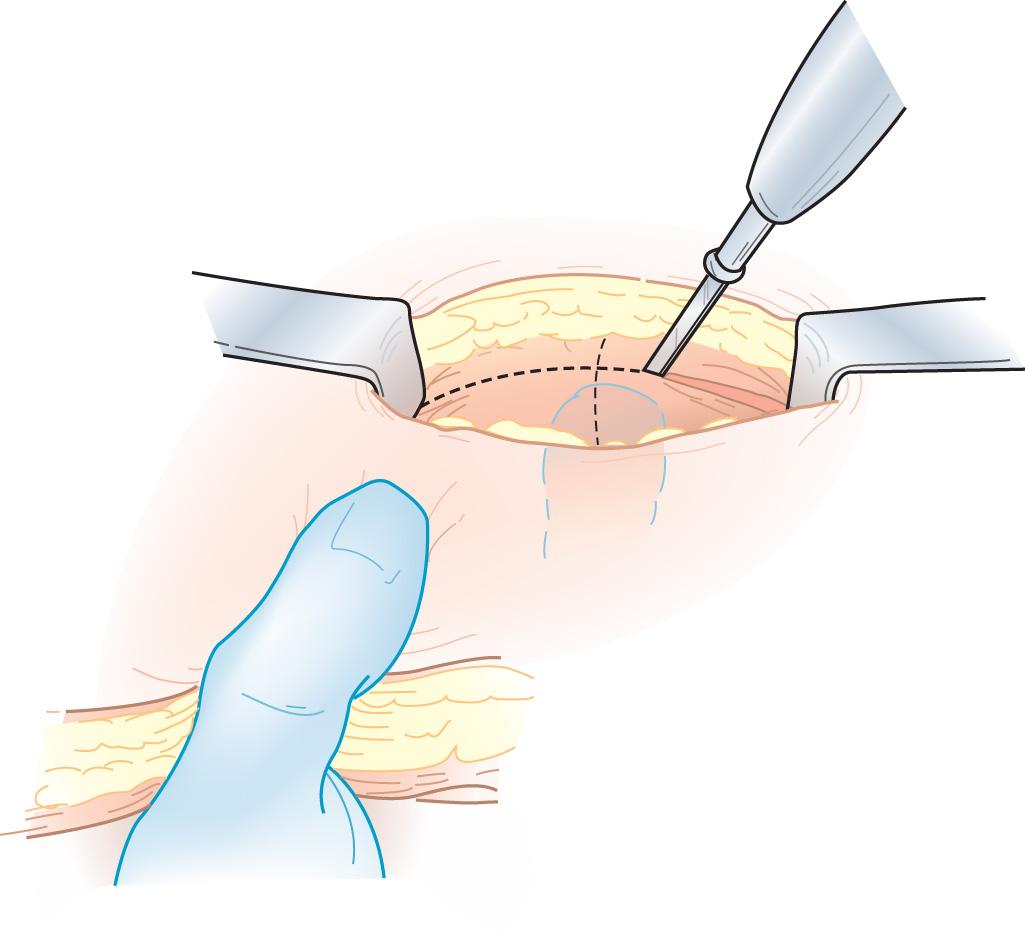
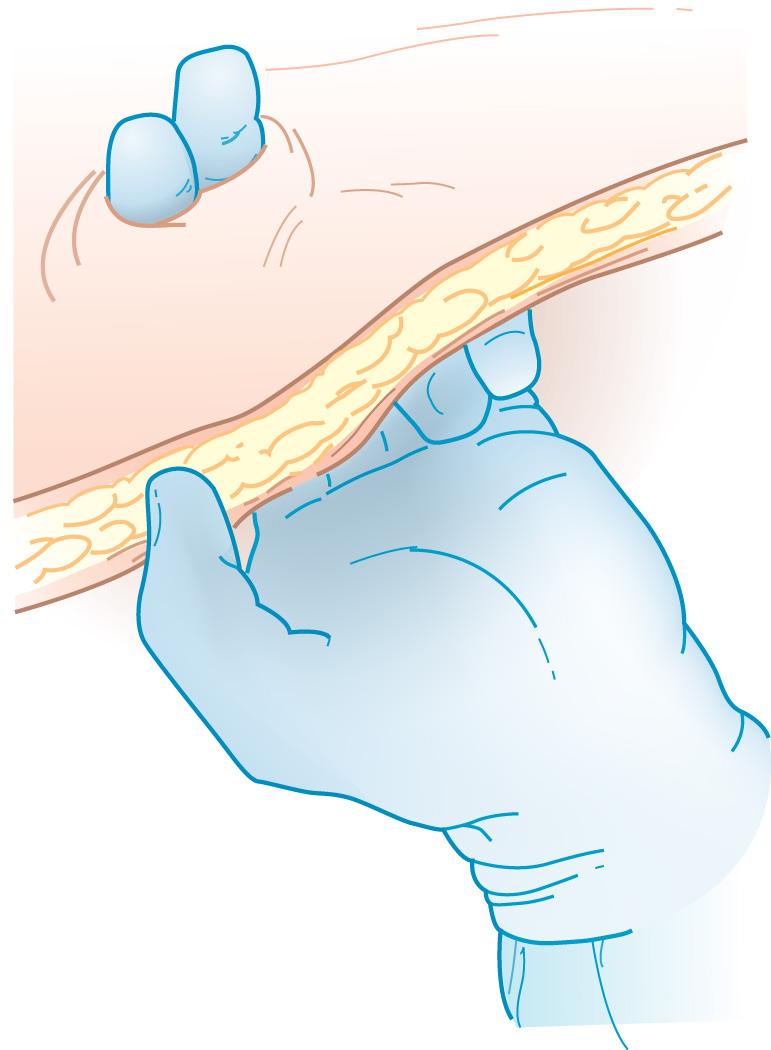
After the abdominal wall defect has been created, the ileum is prepared. Any residual retroperitoneal attachments are divided to facilitate passage of the bowel through the abdominal wall without tension. The mesentery may be cleared from the terminal 5 to 6 cm of the ileum. However, care is taken to leave at least a 1-cm strip of mesentery with the ileum as this generally carries a vessel paralleling the ileal wall and will prevent stomal ischemia ( Fig. 178.5 ). The ileum is then oriented with the cut mesenteric edge cephalad and passed through the previously created defect in the abdominal wall. The ileum should protrude 5 to 6 cm beyond skin level and appear pink and well perfused. The lateral ileal gutter may be closed if desired to prevent small bowel obstruction secondary to small bowel rotating around the ileostomy. This is done by suturing the free edge of the ileal mesentery (taking care to avoid blood vessels feeding the stoma) to the abdominal wall lateral to the midline incision up to the falciform ligament. There is no need to suture the ileum to the posterior fascia of the abdominal wall because this has not been shown to decrease the risk of prolapse or hernia. The abdominal incision is then closed in routine fashion including the skin.
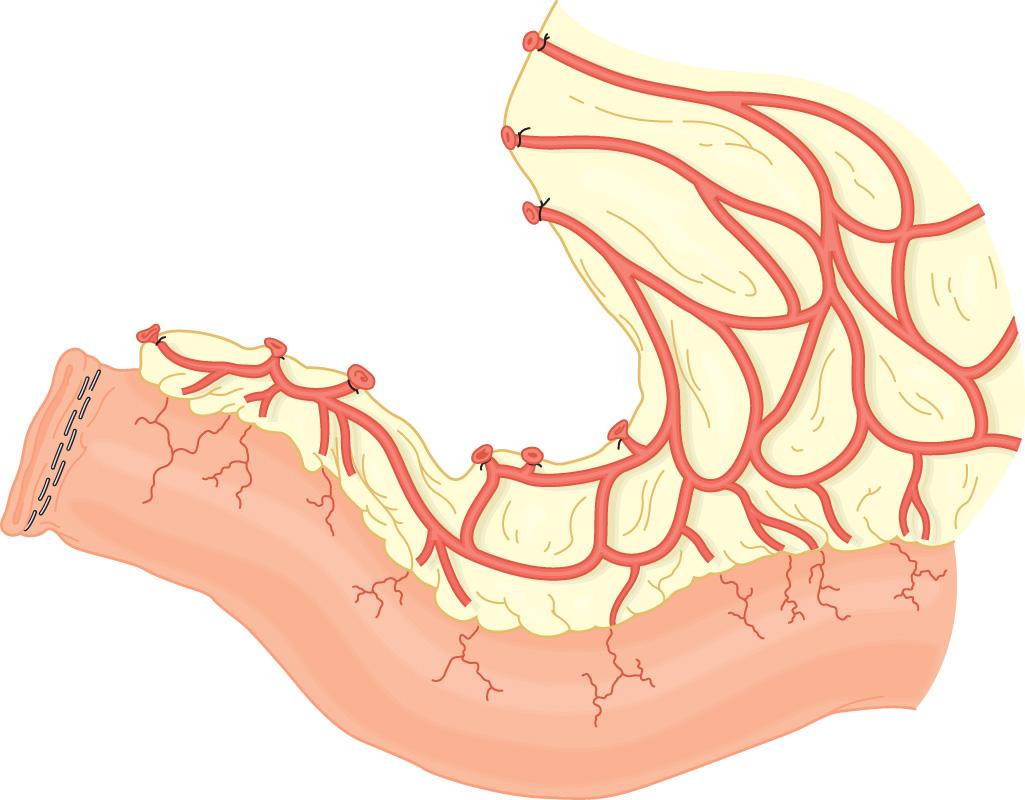
The incision is protected to prevent contamination with intestinal contents and the staple line removed from the ileum. Ileostomies must be everted and matured to prevent serositis and skin irritation because of the caustic nature of the ileal effluent. This is accomplished by tripartite sutures containing dermis, the seromuscular layer of the bowel at the fascial level, and full-thickness bites of the cut edge of the ileum ( Fig. 178.6 ). Three or four of these everting sutures are placed at the ordinals without tying. General traction on these sutures facilitates eversion of the ileum. After the stoma has been everted, the enterocutaneous anastomosis is completed with sutures between the cut edge of the ileum and dermis. These additional sutures (4 to 8) approximate the bowel mucosa to the dermis. The bowel should appear pink and protrude 2 to 3 cm beyond the abdominal skin.
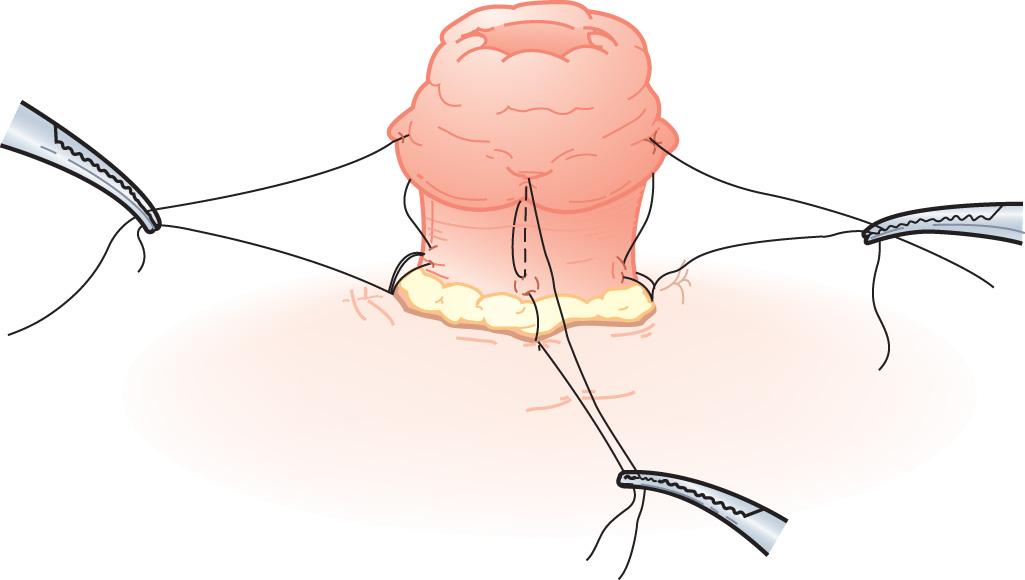
As previously discussed, left-sided end colostomies are usually created in association with distal colorectal resection. The lateral attachments of the colon are transected along the white line of Toldt until sufficient colon is mobilized to create a colostomy that protrudes from the abdominal wall and can be matured without tension. After the colon has been sufficiently mobilized, the stoma site is prepared and the abdominal wall defect created similar to that described for end ileostomy. The only differences are that the premarked stoma site is usually in the lower left quadrant and the cutaneous and fascial openings may need to be slightly larger to facilitate unrestricted passage of the colon through the abdominal wall.
After the ostomy site has been successfully created, the colon is oriented without twisting and passed through the abdominal wall. Again, the colon should protrude beyond the abdominal skin and appear well perfused. There is no need to close the lateral gutter or to suture the colon to the posterior abdominal fascia as neither of these maneuvers has been shown to prevent parastomal hernia or prolapse. Alternatively, a retroperitoneal colostomy can be created by tunneling the colon under the posterolateral peritoneum and exiting through the previously created stoma site. This has been associated with decreased rates of parastomal herniation and prolapse, but the increased technical demands with its creation have limited its utility.
After the abdominal incision has been closed and protected, the colostomy can be matured. Colostomies may be sutured with minimal eversion because distal colonic contents are not irritating to the surrounding skin.
Meagher et al. have devised a technique helpful in creating an end sigmoid colostomy in patients with a thick abdominal wall. The stoma site is created in standard fashion. A small wound protector (used in laparoscopic specimen extraction) is then inserted into the stoma trephine and opened maximally. The bowel is then passed through the wound protector. The inner ring of the wound protector is transected and removed. The remaining wound protector is brought out externally. The authors suggest this technique decreases spillage and minimizes bowel trauma during stoma exteriorization, particularly in the obese patient.
A variation of end stomas is the loop end stoma. This type of stoma is useful in obese patients or those with a shortened or thickened mesentery. In these patients, it is difficult to get the stoma to reach the skin or the bowel's blood supply may be questionable. A distal loop of bowel is selected and using an umbilical tape for traction, the loop end (close to the bowel end) is brought through the abdominal wall without dividing the mesentery ( Fig. 178.7 ). A stomal rod is helpful in maintaining traction, and the bowel is matured as in a traditional loop stoma (see next section). This type of stoma can be made from ileum or colon.
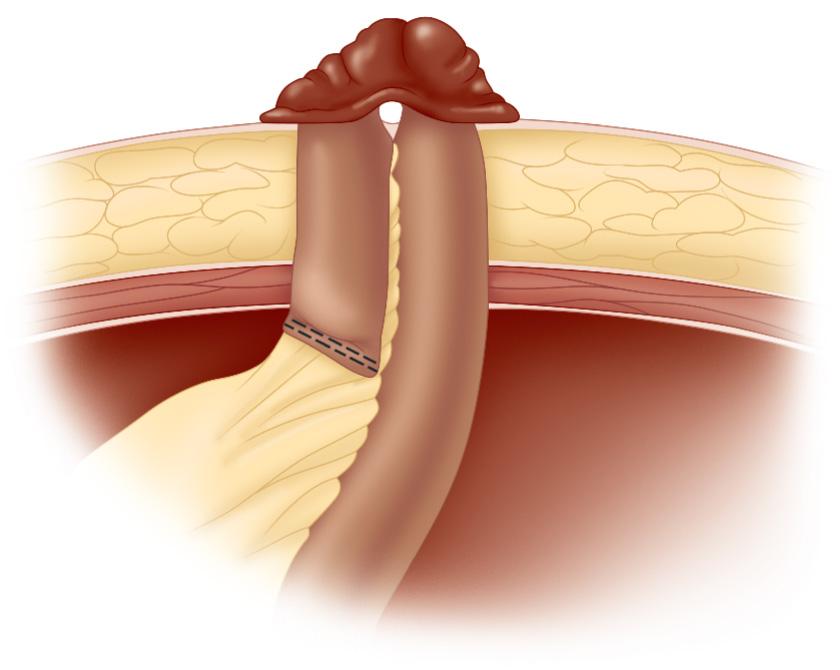
As previously mentioned, diverting or loop stomas are created to divert the fecal stream away from the “downstream” intestine. Diverting stomas consist of three types: loop ileostomy, loop colostomy, and end loop stomas. In the past, the most common loop stoma created was the transverse loop colostomy, popularized for the treatment of complicated diverticular disease and for protection of distal anastomoses. The transverse loop colostomy is often a poorly tolerated stoma with high complication rates and therefore has largely been replaced by the loop ileostomy. In addition, anywhere a loop ileostomy or a loop colostomy is planned, an end loop ileostomy or end loop colostomy can be performed at the surgeon's discretion.
The loop ileostomy is generally created in association with distal bowel resection. After the resection and/or anastomosis have been completed, a segment of terminal ileum is selected. The most distal segment of the terminal ileum that will reach the abdominal wall without tension is selected. This generally corresponds to a segment 15 to 30 cm proximal to the ileocecal valve or from an ileoanal reservoir. The ileum is encircled with a Penrose drain or umbilical tape after its mobility has been ensured.
An abdominal wall defect is created as previously described for an end ileostomy. The defect may need to be slightly larger to accommodate both loops of bowel, which, by necessity, pass through the abdominal wall in a loop stoma. Before passing the ileum through the abdominal wall, proper orientation is ensured and the distal end is marked with a suture to prevent maturation of the incorrect segment after the abdominal incision has been closed. The ileal loop is passed through the abdominal wall without twisting and should protrude 4 to 5 cm beyond the abdominal skin. The midline incision is closed appropriately and protected with a cutaneous drape. The distal aspect of the ileum just above the abdominal wall is transected along approximately 80% of its circumference (from mesentery to mesentery). The distal end is then matured with simple sutures between the full-thickness terminal bowel and dermis. These sutures are placed close to one another to reserve the majority of the stoma site for the functional, proximal stoma.
After the distal end has been sewn to the abdominal skin, the proximal end is everted. Three tripartite bites are taken between the dermis, the seromuscular layer of the ileum 5 cm proximal to the transected end, and a full-thickness bite of the open end of the ileum. After the three sutures have been placed, they are tied with gentle traction applied within the lumen to facilitate eversion. Maturation is completed with two additional sutures between the dermis and the full thickness of the terminal ileum ( Fig. 178.8 ). The loop stoma should protrude adequately, with its functional end occupying approximately 80% of the trephine circumference. Unless undue tension is present, a support rod is generally not necessary.
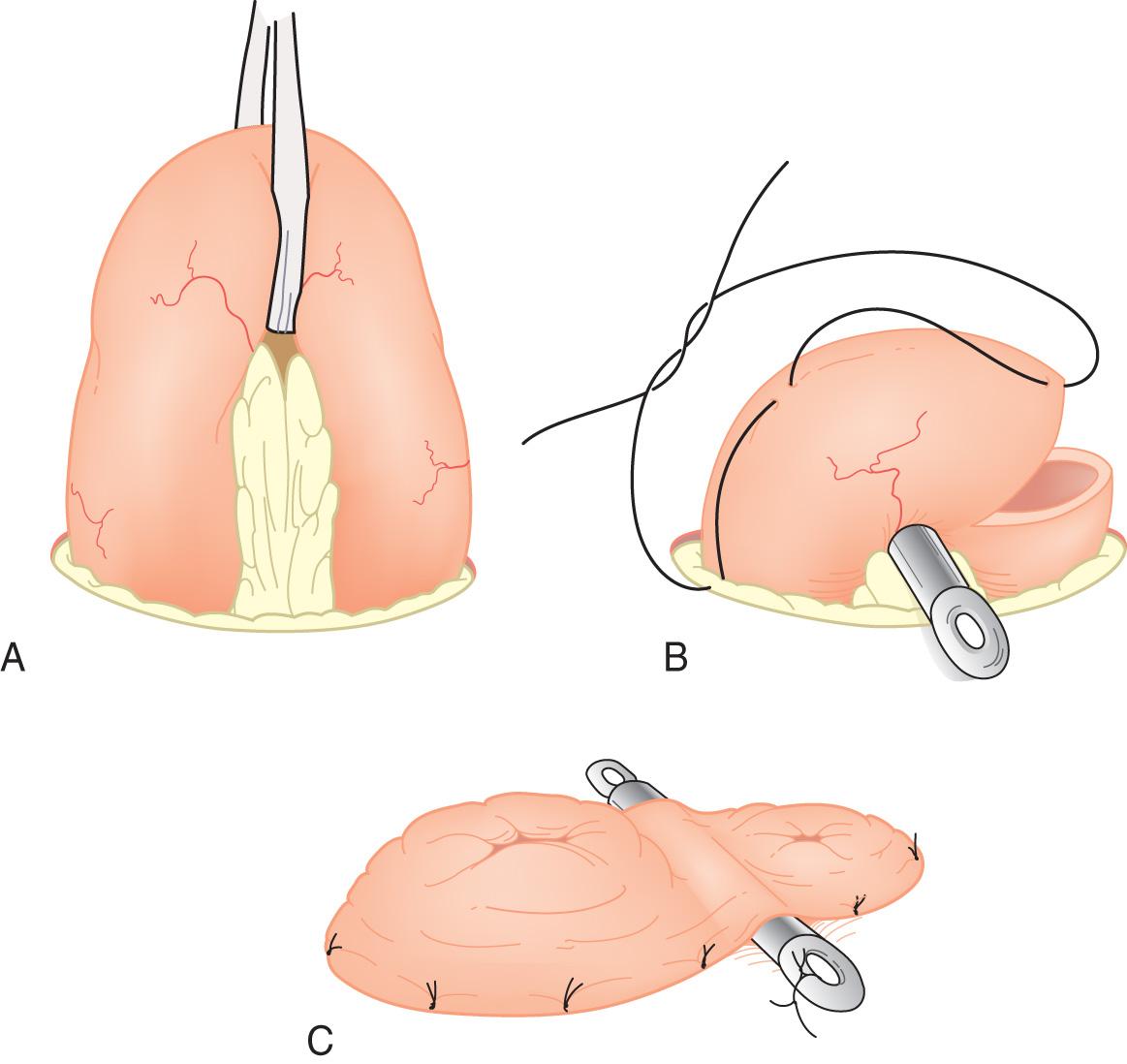
A loop sigmoid colostomy may be created to prevent the fecal stream from reaching the rectum and anus in cases of incontinence, severe anorectal infection, or for proximal protection after complex anal reconstruction. This stoma is essentially created in identical fashion to that of a loop ileostomy, with the exception that the stoma is commonly placed in the left lower quadrant. Eversion is not strictly necessary because of the noncaustic nature of the effluent from the left colon. However, in many circumstances, an end loop or divided loop stoma, as described in the following section, is easier to create and functions better than the standard loop colostomy.
There are three types of end loop stomas : end loop ileostomy, end loop colostomy, and end loop ileocolostomy. These stomas have three main benefits: (1) they often make stoma management easier in the postoperative period because they appear very similar to end stomas, (2) they can be created with remote sections of the intestine, such as an end loop ileotransverse colostomy, and (3) they do not require formal laparotomy for stoma takedown. The end loop ileostomy and end loop colostomy can be created in any situation in which a standard loop ileostomy or loop colostomy might be performed. End loop ileocolostomies can be created in association with intestinal resection. For example, a right colectomy may be performed for right colon trauma or for right colon ischemia and an anastomosis is deemed unwise. In this situation, the ileostomy and the transected edge of the proximal transverse colon can be brought through one single stoma site, avoiding the need for a second stoma and laparotomy at the time of stoma takedown.
Following intestinal resection and creation of an appropriate abdominal wall defect, the end loop or divided loop ileostomy is created as follows: A small defect is created in the mesentery at the preselected ileal stomal site. The bowel is then transected with a linear stapling device. The proximal or functional end of the ileostomy is brought through the abdominal wall as for a standard end ileostomy. The nonfunctional segment can be managed in several ways. It can be brought through the fascia and sutured to the functional bowel or scarpa fascia. This method completely diverts the bowel. Another option is to bring the antimesenteric corner of the distal nonfunctional bowel through the same stoma site. The incision is closed appropriately. The antimesenteric corner of the distal staple line is transected, and the small opening in the distal bowel is matured to the abdominal wall without eversion. The remainder of the staple line lies buried in the subcutaneous tissue. The proximal bowel is then everted and matured in a similar fashion to any end ileostomy ( Fig. 178.9 ). A single suture between the proximal end ileostomy and the distally matured segment connects the two and completes the maturation. These stomas completely divert the fecal stream and appear almost identical to end ileostomies.
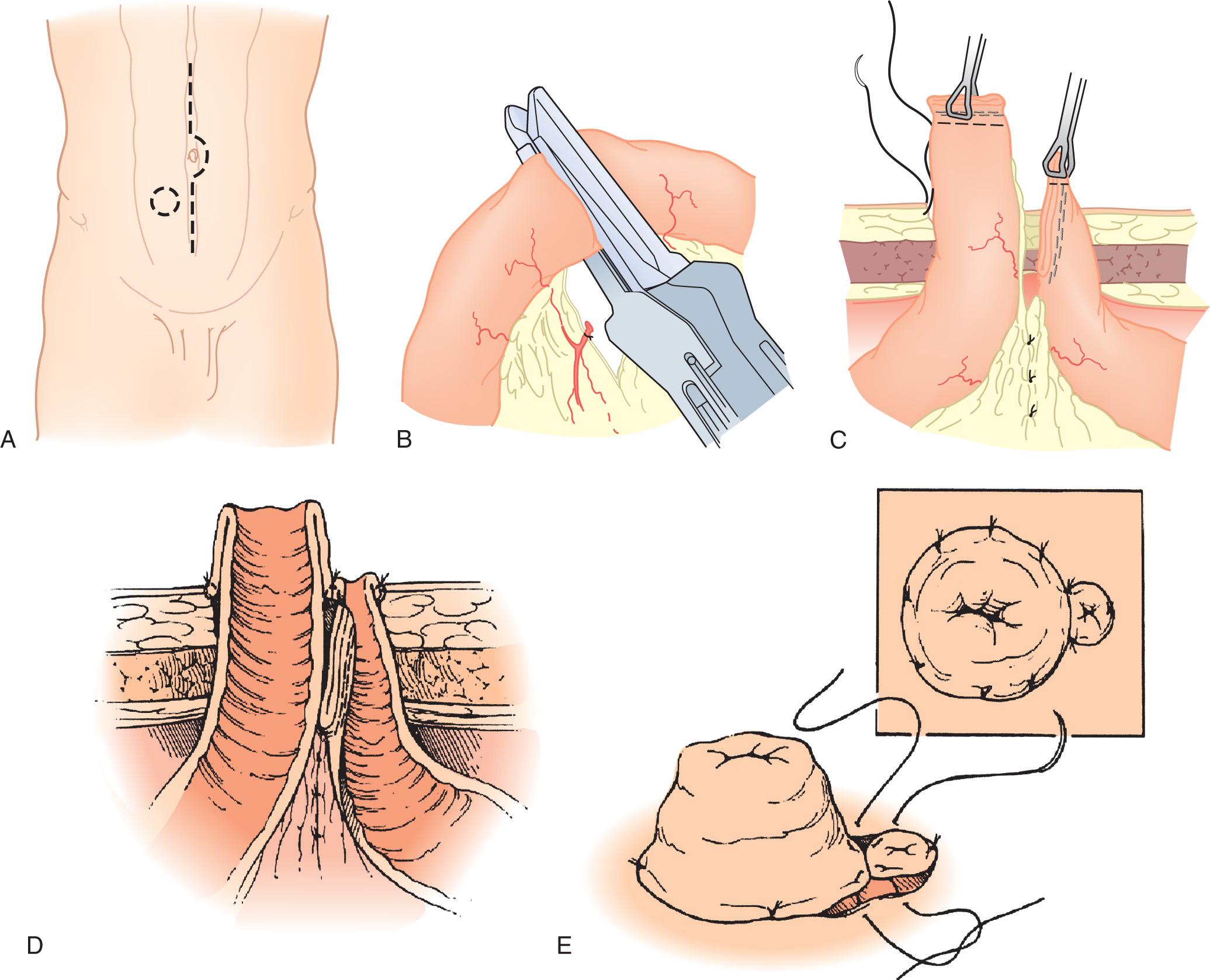
The end loop colostomy is created with a preselected segment of the sigmoid colon. It is mobilized appropriately and passed through the previously created abdominal wall defect similar to that of an end loop ileostomy. The abdominal incision is closed appropriately. The end colostomy is matured in a similar fashion to that of the end loop ileostomy. As previously mentioned for loop colostomies, the proximal end may be everted but a flush colostomy may also be created.
An end loop ileocolostomy can be performed in association with resection of the right colon when an anastomosis is unsafe. Following resection, the terminal ileum is prepared as for any routine end ileostomy. Often a stoma site will have to be created in the right upper quadrant to facilitate passage of the ileostomy and the distal transverse colon through the same abdominal aperture. After the stoma site has been created, the terminal ileum is brought through the abdominal wall, similar to an end ileostomy. The stapled-off end of the proximal transverse colon is brought through the abdominal wall defect. The mesenteric defect can be closed as with any standard colon resection.
Following this, the abdominal incision is closed in routine fashion. The antimesenteric corner of the transverse colon staple line is then transected and matured without eversion to the abdominal wall stoma site. Cutaneous sutures should be placed in proximity to save the majority of the stoma site for the ileostomy. After this has been completed, the staple line is resected from the terminal ileum and the ileum matured as for a standard end ileostomy ( Fig. 178.10 ). The final suture between transverse colon and the ileum is placed to complete the maturation.
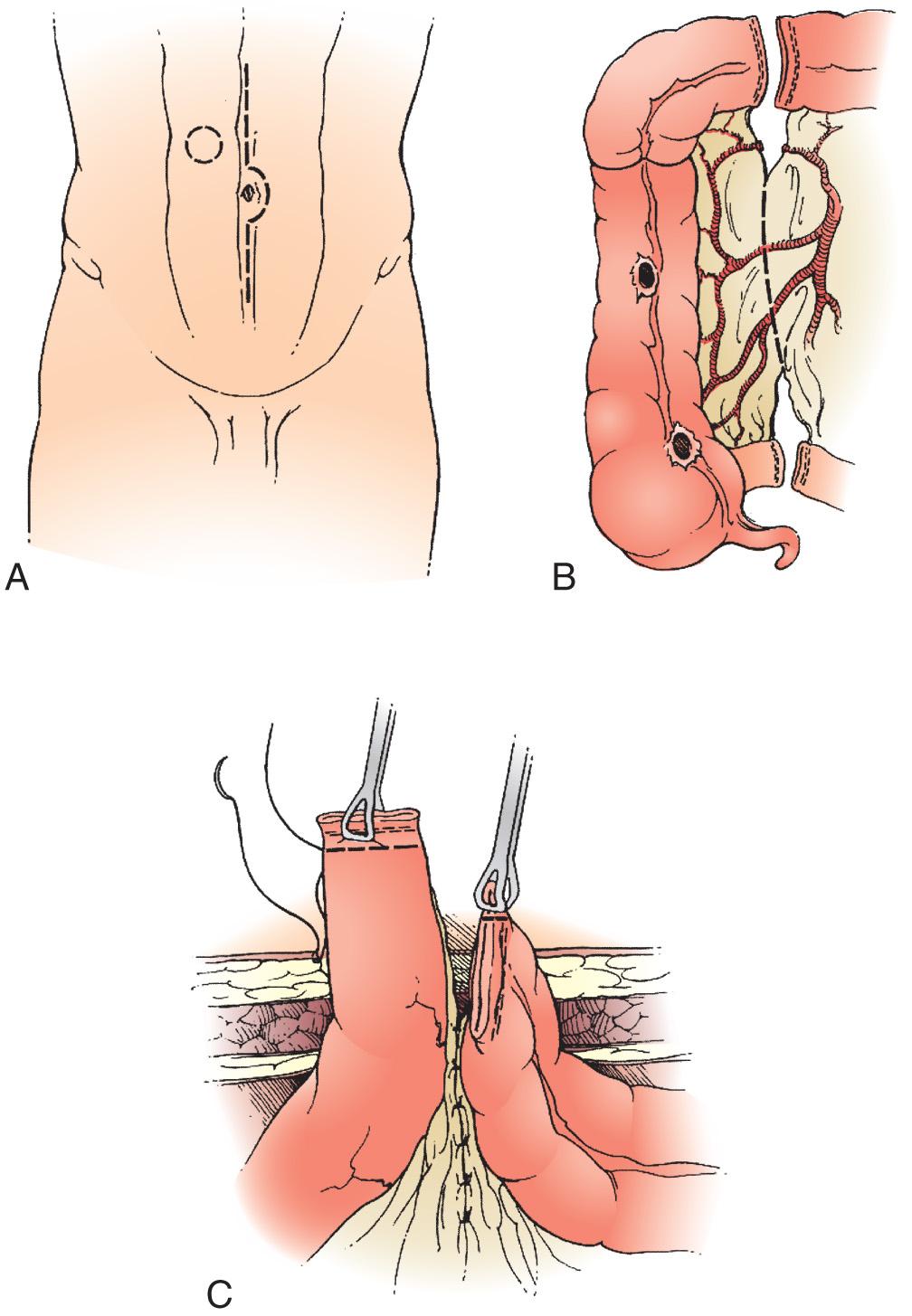
This stoma has the previously mentioned advantages of avoiding a second stoma site for a mucous fistula. In addition, because the terminal ileum and transverse colon are in close approximation through the same stoma site, stoma takedown can be later performed directly through a parastomal incision without the need for a formal laparotomy. This may significantly decrease subsequent morbidity and recovery time after the subsequent stoma takedown.
If an ileostomy is needed in conjunction with a laparoscopic bowel resection (protection of a low anastomosis) or an ileostomy alone is needed (diversion proximal to complex anovaginal fistula repair or anal canal reconstruction), it can be created laparoscopically. Principles that apply to open ileostomy creation also apply when the operation is performed laparoscopically. The site should be selected according to the patient's body habitus and functional needs. If a colectomy in conjunction with the ileostomy is essential, then ileostomy siting should be considered at the time of trochar placement. A trochar can certainly be placed through the future stoma trephine, but sites adjacent to the trephine within the footprint of the stoma appliance should be avoided. Trochars in place for the colectomy or proctectomy can be used to perform the intracorporeal components of the ileostomy creation.
If the ileostomy is created without any additional abdominal surgery, then only two ports are commonly necessary: one at the umbilicus for the camera and a second through the stoma site to manipulate the terminal ileum. Under either circumstance, the operative principles are similar.
The terminal ileum is located just proximal to the ileocecal valve. The bowel is followed retrograde until a segment that easily reaches the abdominal wall at the stoma site is identified. Pneumoperitoneum should be deflated when assessing ileal length, as the abdomen will not be distended when the ileostomy is created or in use. Ileal mobilization is rarely required. Extreme care should be taken to ensure proper orientation of the bowel. The proper loop of bowel is grasped with a grasper through the stoma trephine and proximal and distal bowels carefully identified. If an additional port is available, the tip of a marking pen is grasped with a laparoscopic grasper and the distal end marked just beyond the grasper. (This is not possible if the two-port technique is used.)
Pneumoperitoneum is released, and the stoma trephine is created in standard fashion around the grasper. The loop is then eviscerated carefully without twisting. After this is done, pneumoperitoneum is reestablished and proper orientation is confirmed. (This is essential because creating an ileostomy from the distal limb is highly problematic for the patient [because it can lead to an unanticipated mechanical small bowel obstruction] and very embarrassing for the surgeon.) After proper orientation is confirmed, the stoma can be matured in standard fashion. A loop, end loop, or end ileostomy can be created as indicated based on the clinical setting. After completion of stoma maturation, pneumoperitoneum is reestablished, proper orientation confirmed, and the abdominal cavity is checked for bleeding.
Similar to ileostomy, all types of colostomies can be performed laparoscopically. Sigmoid colostomy is most common. Techniques are very similar to the creation of laparoscopic ileostomies. If trocars have been placed for rectosigmoid resection, no additional ports will be needed. If a colostomy is performed without other abdominal surgery, then three or four ports may be necessary. A camera port is placed through the umbilicus. Two ports are placed in the right midabdomen and the right lower quadrant, respectively. A fourth port may be placed through the previously marked stoma site, if colonic mobilization is required. If the colostomy is created in conjunction with an abdominoperineal resection or sigmoid resection, mobilization is often already completed at this point. Occasionally, additional descending colon mobilization is necessary to create a stoma without tension.
If no colonic resection has been performed, then the sigmoid and descending colon will require mobilization. The sigmoid colon is retracted medially through the right midabdomen port, and the lateral peritoneal reflection is retracted laterally through the stoma port. The lateral attachments are then taken down with scissors or cautery through the right lower quadrant port. After mobilization is complete, pneumoperitoneum is released and the colon checked for length. Again, the distal end is marked with a marker tip attached to a grasper (if distal resection has not been performed) after orientation has been carefully confirmed.
Pneumoperitoneum is then decompressed, and the stoma trephine created in standard fashion. The colon is brought through the abdominal wall defect without twisting and the stoma matured with standard technique. As with ileostomy, end, end loop, or loop colostomy can all be created laparoscopically. After stoma completion, pneumoperitoneum is reestablished, orientation confirmed, and the abdominal wall cavity checked for bleeding.
Patients who may benefit from these techniques include those with stomal retraction (especially those who have bowel limitations, e.g., continent ileostomies, dense intraabdominal adhesions or short gut; prolapse; large peristomal hernias; abdominal wall laxity, usually resulting from major weight loss) and peristomal skin problems, such as pyodermia. In many of these patients, stomal relocation may not be the best option.
The technique is similar to that used by plastic surgeons. A low curvilinear transverse incision is made at the inferior abdominal fold or 2 to 3 cm above the pubis and anterior superior iliac spines ( Fig. 178.11 ) and carried down to the fascia. A flap of skin and subcutaneous tissue is created by electrocautery dissection in a cranial direction, just above the fascia. Perforating vessels are identified and ligated or cauterized. As the dissection continues, the stoma will be encountered. With the flap on traction, the intestine is separated from the skin and subcutaneous tissue. Care is taken to avoid injury to the bowel or its blood supply. The dissection should err on leaving additional subcutaneous fat attached to the intestine. This can be carefully resected later. A similar maneuver may be performed at the umbilicus if the surgeon and patient prefer to preserve it in its normal location. Again, care is taken to preserve the tissue's blood supply. If the umbilicus is not to be maintained, it can be amputated at the fascial level. The flap dissection is continued cranially just above the fascia until enough laxity or length is obtained in the upper flap for the upper edge of the previous stomal opening to reach the inferior portion of the incision without excessive tension or to the costal margins. Any associated peristomal hernia can be repaired at this time with suture repair of the fascia and/or mesh (synthetic or biologic) reinforcement.
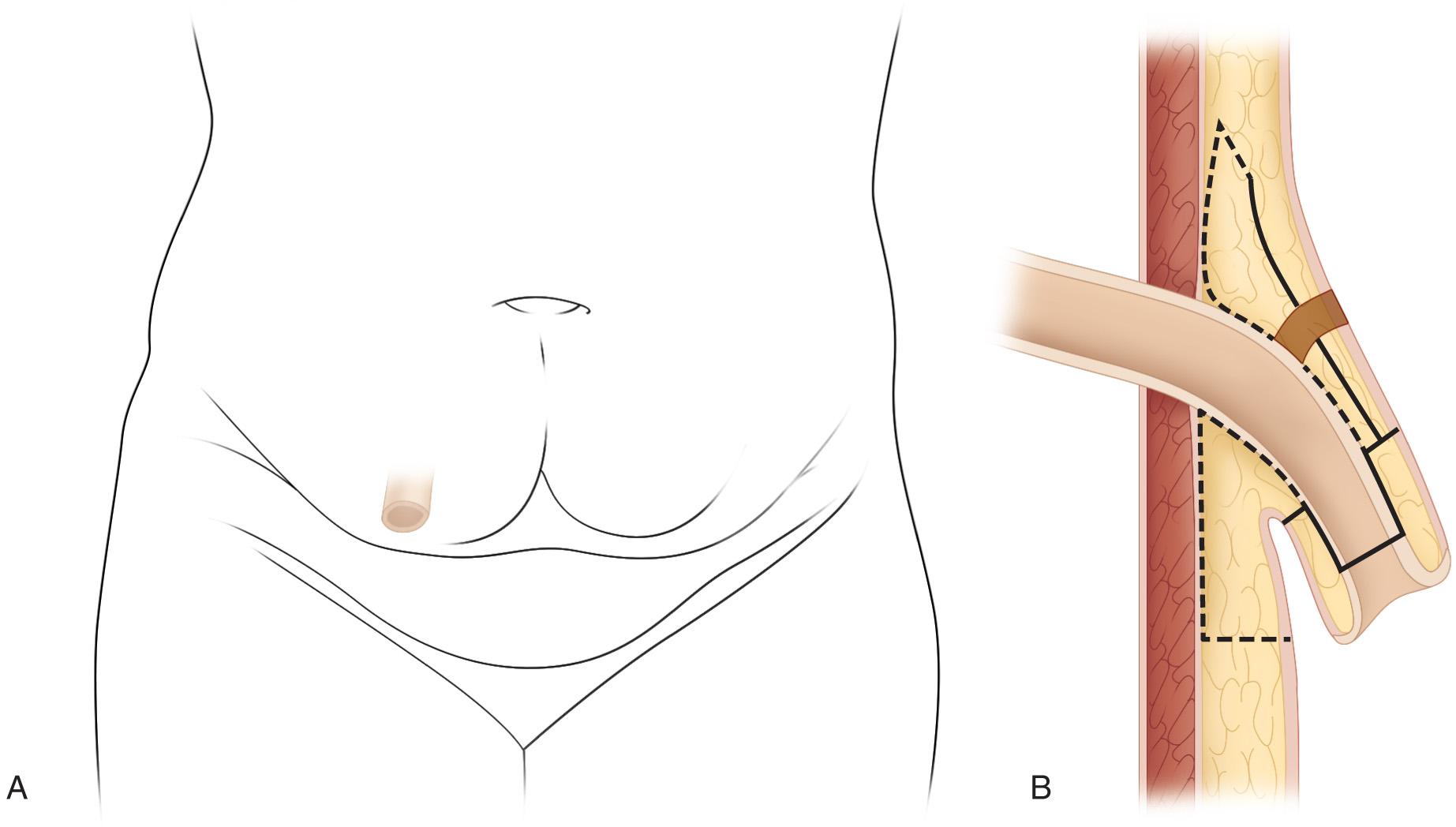
As the flap is retracted inferiorly, new sites for the ostomy and, if desired, the umbilicus are selected and openings created in the flap. Excess subcutaneous fat can be carefully removed to thin the flap. Fortunately, there is usually less subcutaneous fat above the umbilicus compared with below it. The excess, distal portion of the flap is excised (see Fig. 178.11 ). The intestine and umbilicus are brought through the respective flap openings and matured with interrupted absorbable sutures. Excess bowel or umbilical tissue can be carefully excised. Closed-suction drains are placed below the flap to avoid seromas and the inferior incision is closed in layers. Because intraabdominal dissections are avoided with this technique, patients usually recover quickly. Morbidity is usually associated with infection, flap ischemia, or seromas. These are managed with wound care.
Several types of flaps can be used to modify the abdominal wall around the stomas. Most involve peristomal dissections and removal of skin and subcutaneous fat. The medial approach starts with an incision through the midline incision down to the fascia ( Fig. 178.12A ). Dissection is carried laterally just above the fascia until the stoma is reached. The ostomy is dissected free of the skin and subcutaneous tissue as described previously. After the stoma is freed, lateral dissection to the flanks will provide enough laxity to advance the previous stoma site to the midline (advancement flap). As above, a new ostomy opening, in fresh skin, is created. Excess fat may be excised around the stoma, and redundant midline skin is resected.
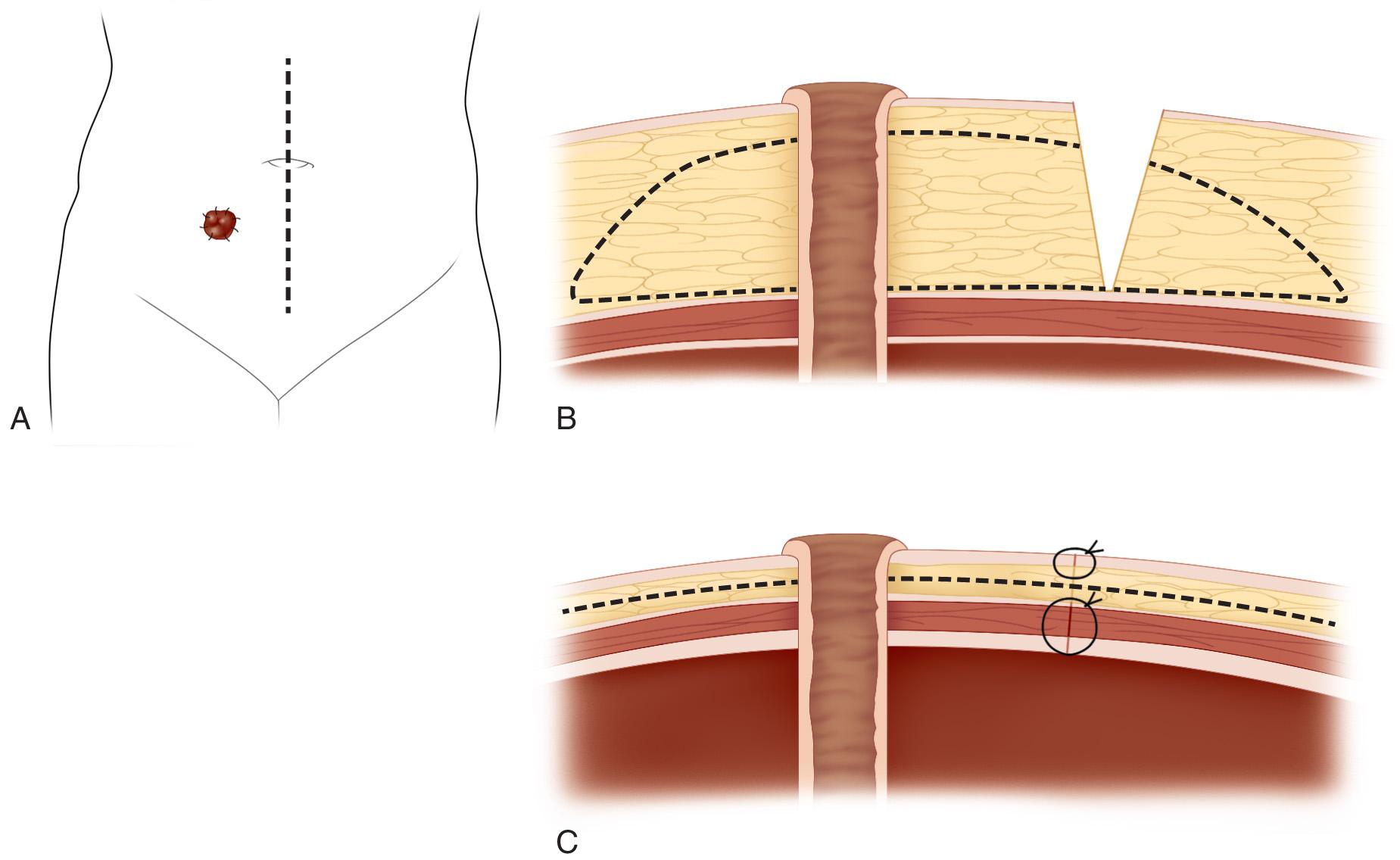
If the skin flap is not redundant enough to advance the original ostomy opening to the midline, the subcutaneous fat can be excised and the stoma returned to its original skin opening through the thinned flap. Either method is performed in such a manner to leave a smooth, flat, thinned flap that provides a flat surface to site the appliance. The stoma is matured, and the midline incision is closed. Subcutaneous closed-suction drains are placed above and below the stoma. A similar technique can be used through an inferior or inferolateral peristomal incision.
Rapid and significant weight gain in ostomy patients may produce stomal retraction. If attempts at weight loss have not been successful and stomal revision is not desirable or feasible (e.g., continent ileostomy or short gut patients), liposuction is an excellent option. This method is preferred if there is no associated stomal stenosis or hernia. Experienced plastic surgeons can carefully use liposuction techniques to remove subcutaneous fat around the stoma. Obviously, care must be taken to not injure the stoma during the procedure and to leave a flat smooth peristomal skin surface for the ostomy faceplate. After the fatty tissue is removed, it will not be redeposited despite additional weight gain.
Become a Clinical Tree membership for Full access and enjoy Unlimited articles
If you are a member. Log in here